How we view our history and future can be skewed, or even screwed if we don't see either well. I promised my readers I would…

Gurus
Gurus
My first night in Bombay, sleeping on the woven mat cot, a small lizard dropped on my forehead. “Yeow!” I jumped.
“What happened?” I heard from the other room.
“A lizard landed on my head!”
“Very auspicious,” they said, laughing.
In the hot summer of 1971, at age 26, I had left my seminary to tour India with my guru/friend, Dr. Vasavada, and to meet his guru, the Blind Saint of Vrindivan.
By the time I got my funeral director’s license in 1967 I had learned I liked college. Chemistry (and scientific orderliness), Anatomy and Physiology (my favorite subject ever), Logic (persnickety but reliable), Comparative Religion (especially Eastern), and Psychology (especially Jungian) – enthused me. After getting a bachelor’s in Psychology and Philosophy, I had put in two years on a Masters of Divinity at a liberal seminary at the University of Chicago.
The formal stone building at 57th and Woodlawn reminded me of my old mortuary school back in Detroit. (Coincidently, the seminary’s Unitarian religion had roots in Transylvania, and the mortuary school had a Transylvanian castle stored in crates in its basement.) The reclusive Mircea Eliade, preeminent scholar of the History of Religions, author of three feet of scholarly books and another three of novels, had his office on the third floor. Only rarely did we see him, though.

I had luckily met and befriended Dr. Arvind Vasavada. He had come to Chicago to start his practice. Originally of Bombay, he had just trained with Dr. Carl Jung in Zurich. Arvind became a sort of a guru and friend to me. I drove him about Chicago, and enjoyed meditation groups, meals, and conversations about Jung and Krishnamurti with him. He saw the seeker in me.
Sometimes I would go to him for his free counsel, all full of angst over some upset. He’d smile and gently say, “Be in it.”
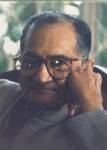
While landing in the Boeing 747 in Bombay (later called Mumbai), I saw buffalo grazing near the runway. Bare-backed laborers, carrying concrete pallets on their heads, climbed barefoot up four floors of bamboo scaffolding, building a new terminal.
Dr. Vasavada’s daughter lived in the city. As in many Indian homes, a photo of John Kennedy hung on the wall. Meeting Vasavada there, we planned to tour. But fortunately and temporarily, his guru, the Blind Saint, was to be in near-by western Gujarat State the next day, holding satsang (truth speaking) with another blind notable guru. Was this to be ‘the blind leading the blind?’ I joked in my mind.

The Blind Saint, Swami Sarananda (or was it Sharaanandaji? I never got it right) was a big bronze man with thin, long white hair and beard, and he used a sturdy walking staff as tall as him. Huge belly, all golden tanned. He wore the simple cotton white dhoti of his culture and sandals, nothing else. The room smelled of incense and sweat. About ten Indian sadakas (seekers) sat respectfully on the floor to hear the sadhana (teachings) of the revered gurus. Flies buzzed annoyingly around everyone’s head, but Swami didn’t seem to mind.
I would find out India was like that: the mother-land of the holy, ridden with flies ─ peacocks and vultures, saints and thieves.
Swami spoke in Hindi; I had no idea what he said. Every exchange had to be run through interpreters. Vasavada introduced me to him.
What questions had I brought? I didn’t know yet, I was just soaking in the scene and feeling honored to be close to a supposed saint.
When I asked my question, though, his devotees didn’t want to translate, thinking it was rude. It wasn’t rude; it was sincere: “What’s it like to be a saint? How is that different than being an ordinary person?”
They winced; Swami laughed. “A saint is a member of the universal human family.”
Secretly, I wanted more. Familiar with LSD and other substances like it, I wondered if a living saint could bestow a taste of Self, enlightenment via osmosis during mere darshan (close company). Raised Catholic, I wondered if there really are guardian angels and halos. I wanted what I doubted. Having disdain for how western religion seemed to restrain and exploit life in hopes of an afterlife, I hoped eastern religion could provide heavenly experiences here in this life. His “universal family” answer seemed generic and evasive, but I went with it.
I asked, “I am ashamed of my country’s war in Vietnam. What can I do to protest it?”
He asked a question in return. “What is the cause of war?” My mind went to the usual answers: racism, resources, the sense of ‘us and them’. Before I could answer, he supplied it. “The cause of war is men taking fascination with their minds and the products of their minds.”
This seemed an odd answer to me. He went on, “Protest is in the realm of cause and effect. It can create the opposite of what you want.” A fly settled on his sweaty skin.
He took my soft hands and felt them. Knowing I was in seminary, he gave me his spiritual prescription: “Devote yourself in hard physical labor for the benefit of mankind, taking whatever is offered as pay. Do this fully, and when you are exhausted, in deep sleep you will emit an invisible perfume of unlimited affect.”
Hmm, not what I expected, but imaginable. (Years later, I would build dry stack rock retaining walls for decades, often sleeping deeply at the end of the work day.)
The next day, Vasavada got called back home. His two-year old grandchild had fallen from a window and died. Our planned touring together was off. He would return to Bombay, and I was on my own for over a month.
Donning typical white cotton Indian clothes (sort-of pajamas without the prints) I set out across Gujarat, Maharashtra, Madhya Pradesh, Rajasthan and Uttar Pradesh in the 100+ degree heat, travelling by bus, sometimes through dried river beds. Even in small villages, I could find some friendly person to speak English. I never felt afraid.
I ate the local foods, confident my healthy body could manage any pathogens. It didn’t. I had days of runny, raging diarrhea. I had no idea how full of it I could be.
I stayed briefly with a congressman in Udaipur, Mr. Upadiata. Out front of his air-conditioned house, some dark gypsy blacksmiths hammered out hot iron parts by fires in shallow pits near the side of the dusty road. Their family rested in the shade of their home, a huge-wheeled, ox-drawn cart.
On the outside bend of a river near Aurangavad, a big tribe of wild monkeys (from infants hanging on mothers to four foot tall daddies with long tails) lurked near the tourists visiting the Ellora Caves. From about the years 600 to 1000, dozens of generations of stone-carvers had hollowed out caves in the solid basalt rock. As they carved in, they would leave the existing rock in place, now statues. The original, a dark, cramped ancient stupa (cubical shrine) housed a yoni (vagina) hosting a large Shiva Lingum (penis). Devotees worshipped it by rubbing ghee (clarified butter) on its top and sides. Outside, a woman threw herself down on the ground all day, also worshipping. Next along the cliff face, a Buddha walked out of a huge vagina-shaped door of a sculpted stupa. Then various Buddha statues sat, stood, and reclined in a many-roomed “University.” Finally, an entire huge Hindu temple stood exposed to the sky, but inside, multiple Hindu and big-eyed Jain god-statues of original rock remained. Indian religious evolution was enshrined at Ellora. The monkeys didn’t seem to care; they were intent on grabbing the tourists’ food or shiny objects.
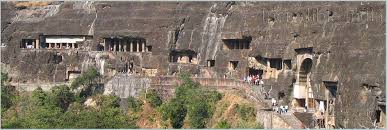
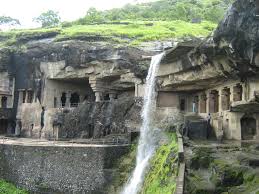
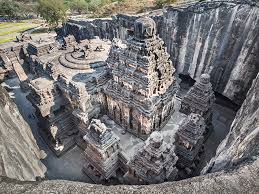
South of New Delhi and just north of Agra (place of the lovely, white Taj Mahal) I visited the home-town of Krishna himself. Vrindivan was a town of ashrams. The Hare Krishna’s had their worldwide headquarters there, as did the Vedanta society. I stayed a week at the Blind Saint’s ashram, Mohna Seva Singh.
The walled compound had small guest rooms with crude wooden doors and shutters. People I didn’t know and couldn’t speak to either lived there or visited. A funeral went through town, the family carrying the corpse of their beloved, banging cymbals and singing. At dusk, in a garden given over to colorful peacocks, a nearly-naked sadhu (spiritual seeker) sat cross-legged. I looked into his eyes, feeling a wave of affection. And just as I did, he sighed as if to say, “I get it too.”
Swami Sarananda ate only one meal a day. He had no possessions beyond his clothes and staff. He devoted himself to meeting seekers and writing books. He had been blind from an early age, but sometimes his greyed, hazy eyes would open and roll down from gazing upward, as if he was looking at me, into me. He was direct, not pretentious.
His teachings were not comfortable or easy. We are the light of self, which shines on what we’re not. We’re not our addictions, feelings or thoughts. We’re not even our body. Renounce what we’re not to allow the real self to shine. Identify with what is imperishable. His was akin to the teaching, “Give what you cannot keep to keep what you cannot lose.”
One day I left my room to visit a monkey shrine. Being a temple, I had to take off my sandals to enter. The open courtyard of blistering hot sand baked by the relentless summer sun burned my feet. “Ouch,” I reacted, running between small spots of shade. Even the monkeys wilted in that harsh heat.
Back to the ashram, I found most my stuff had been stolen. I had picked up various items as gifts for back home. All gone. Suitcases with only a few clothes. Gone was my camera with the photos of me with Vasavada and Sarananda. Gone was my money and passport. Gone was the little bag of ganja I had scored from Babu the rickshaw driver. I filled out the police report, not listing the pot.
“Why didn’t you put a lock on your door?” they asked, incredulous that I would neglect to do such a common thing.
“I thought I’d be safe at an ashram,” I meekly replied.
“Fool,” they probably thought but didn’t say.
I made my way to New Delhi, where the innocent friendliness of those in the villages morphed into the phony friendliness of shop-keepers hawking their wares. It was to one of them, a luggage seller, that I sold my remaining luggage to get the fare for the cheapest train back to Bombay, the people’s train, 3rd Class, the Midnight Express.
Exhausted, weakened by weeks’ worth of diarrhea and loss of muscle mass, I ached for any horizontal spot on the crowded, filthy train. How glad I was to jump on the little eight-inch wide overhead luggage rack, barely holding on to it as my ‘sleeping’ body hung out, cantilevered in empty space partly.
Back in Bombay, one of Vasavada’s family members put me up in their penthouse apartment. From it I could see a huge treed park, the Parsee Towers of Silence, where Parsees left their relatives’ dead bodies for the vultures to eat. Sometimes an odd finger bone would show up on the veranda of the posh apartments.
In contrast, nearby, I saw a community of about a thousand souls, poor people’s bodies all living in ‘housing’ made of haphazard tin and cardboard. They all shared only one water spigot. There was no toilet. Like from the relentless beggars at every train station – the poverty of India, the pain of it, the stench of it, the haunting of it – soaked into my depleted spirit.
I came to resent the eastern belief in maya (illusion). At its simplest, maya refers to mistakenly fearing the rope in the corner as if it were a snake; our ideas of the world are not the world. Or, more extremely, maya can be the supposedly mistaken belief that we are our bodies. Neither our bodies nor the material world are as real and important as the Self.
To me, belief in maya led to hungry, hurting bodies by the millions and rivers festering from all the feces in them. The west exploits life while pining for an afterlife; the east wastes life while longing for an instead-of-life. Neither loves, protects and furthers this obvious, embodied, natural life. I resented it from my emptied, sickened, embodied, grumpy perspective.
I saw a poster for a guru giving satsang (teachings) at a nearby hotel. Shri Rajneesh (later to be called Osho) wasn’t well-known internationally then, but he was notorious in India. He took the tantric path to extremes. Rather than get past desire via denial and repression, his way was to indulge. Sex wasn’t celebrated much between the modern, puritan-like, separated sexes of India, but his young hippy European and American admirers partied hardy.
However, I didn’t know this or him then. All I saw was a man surrounded by admiring women and protective men. There he sat in impeccable whites, a huge Rolex on his wrist, a big jeweled ring on his hand. He had incredibly large, beautiful, and very calm eyes.
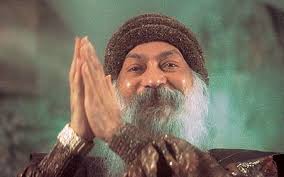
He went on in English about how we are not the body and the manifest world isn’t real. These are all just maya, illusion. He mocked the communists for trying to improve the world.
This irked me. There I was, twenty pounds emptier from all the fire-hose shitting I had done, weak, angry at maya. Maya was as world-avoiding and world-denying as the west’s penchant for an afterlife. What of those thousand, poor people living in squalor near-by?
Only twenty feet away from him, I wanted to go up to Rajneesh, punch him hard in the nose, break and bloody it, cock my fist again, and ask him a practical philosophical question: “If the body is not real and we are not this maya, would you mind if I punch you again?”
Of course, I didn’t. I didn’t dislike him, but I resented his privileged, smug stance. “May he be reborn into that nearby scrappy slum, into a life of hunger, mud and pain,” I thought. Then I took it back. Ahimsa (non-injury) is for all beings, even him. (Later, I came to admire his bold teachings.)
I didn’t accept their invitation to a meditation session on the beach the next morning. Sitting in uncomfortable meditation on a cold beach didn’t appeal to me in my weakened body. But I did have a dream that morning of dancing with them wildly around a big fire. Years later, I learned that’s what their meditations were like.
Going to India was one culture shock; returning to the U.S. was another one. It is one thing to see all the beggars, the rivers fermenting from all the feces floating in them, the flies and vultures. It is another to see fat, frantic people suffering from the glut of frivolous consumerism, oblivious to the murderous war our military waged to protect us from falling dominos, utterly unaware of what our sudden short-term civilization was doing to long-term Mother Earth.
Western civilization had reached the end of its exploits on the west coast of America. Though it sent a general named Westmoreland to Vietnam, there was no more land to the west. The pie-in-the-sky theology of the west ran into the deny-your-eyes theology of the east. Both fail to love Creation, I lamented.
How can we honor the Creator without loving Creation? What if we believed the creation myth on page one of the Bible, Genesis One, where the supposed Creator not only generates an evolving, natural world, complete with plants, animals and humans, but also calls it “good” and advises us to “replenish” it? How would we get, would Creation get, if we were to love and replenish what is actually and naturally good? How healthy? How fulfilled? How good could we and it get?
In this, the gurus seemed as inadequate and misleading as priests and popes. When will our religions direct our care to our bodies, each other, and our ecosystem? These are our universal family. Aren’t we in and of these – at least?
Yet something of Vasavada, Swami, and even Rajneesh, still tugs in me.
Byron Bradley Carrier
Ashland, Oregon
© March 7, 2018




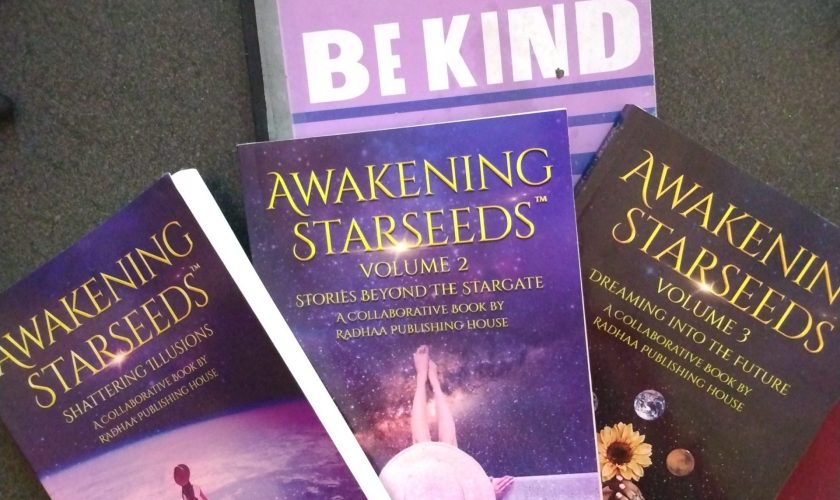


Excellent post! Very well-written. I especially love that last line!
Beautiful writing!! I can identify with many of the irreverently real thoughts you shared.
Thank you!
Thanks, Teja and Coeli. I take ratioinality, skepticism, and irreverence as crucial elements of any realistic religion. I once even had an email name for this sort of radical honesty: “reverendirreverend.” I don’t seek to be contrary or showy, but I’m leery of the showy sanctimony that ruins religioin and hides its shadow aspects.